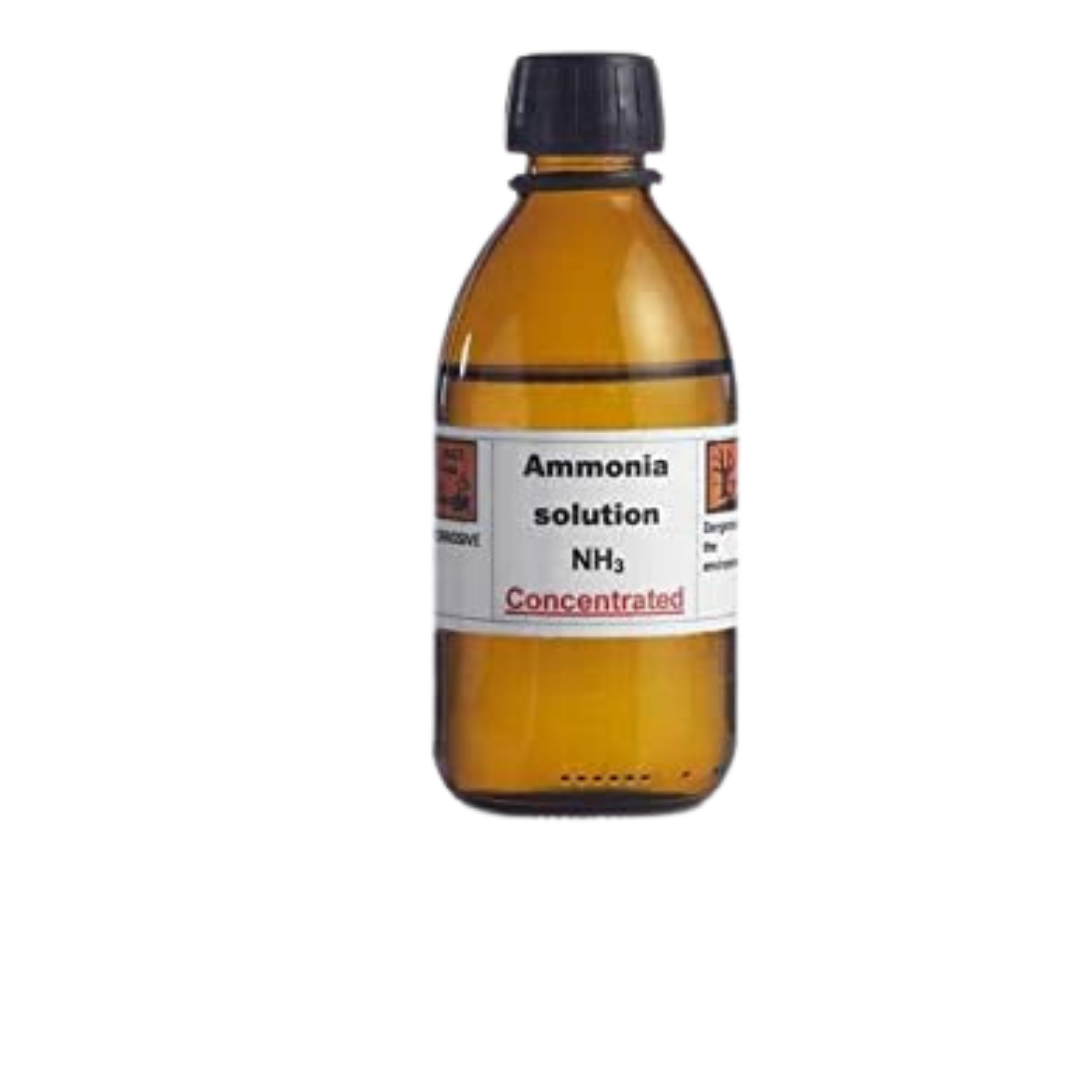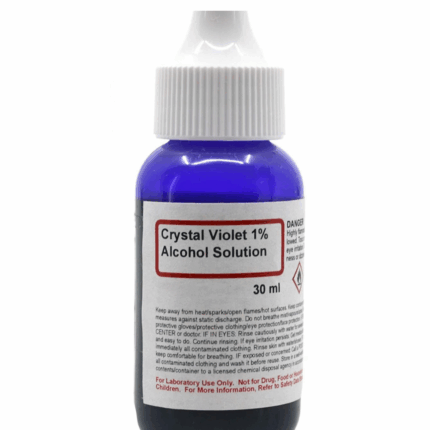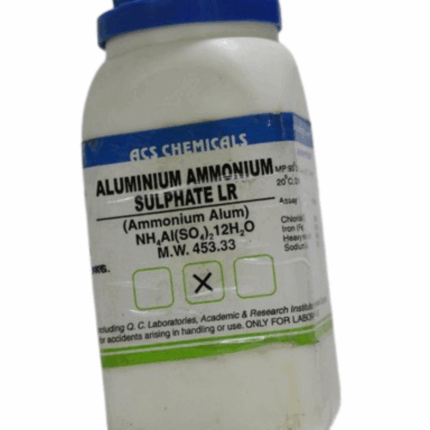Ammonia Solution Extra Pure
SHORT DESCRIPTION
Ammonia Solution Extra Pure is a high-purity, clear, colorless liquid composed of ammonia gas dissolved in water, emitting a strong, characteristic pungent odor. Widely used in laboratory chemistry, it serves as a crucial reagent in acid-base titrations, complexometric analysis, and the preparation of ammonium salts and metal-ammonia complexes. Its alkaline nature makes it valuable for pH adjustment, cleaning of laboratory glassware, and as a reducing agent in certain analytical procedures. The extra pure grade ensures low levels of impurities, supporting reliable results in sensitive experimental work. Due to its volatility and corrosiveness, it should be handled in well-ventilated areas and stored in tightly sealed, chemically resistant containers.
USES
Primary Uses
- Reagent in Qualitative Inorganic Analysis
- Used to precipitate hydroxides of metal cations (e.g., Cu²⁺, Fe³⁺, Zn²⁺), essential in classic group analysis.
- Complexing Agent in Coordination Chemistry
- Forms ammine complexes (e.g., [Cu(NH₃)₄]²⁺); commonly used in ligand substitution and complexation experiments.
- pH Control and Alkaline Buffer Preparation
- Adjusts pH in various analytical reactions; contributes to ammonium-based buffer systems.
- Cleaning and Degreasing Agent
- Employed for cleaning laboratory glassware and removing organic residues, especially in spectroscopy prep.
- Titrant or Reactant in Acid-Base Reactions
- Used in neutralization and back-titration experiments in analytical chemistry teaching labs.
Secondary Uses
- Nutrient in Microbiology & Plant Culture Studies
- Source of nitrogen in experimental nutrient media or hydroponic research.
- Precipitation of Metal Hydroxides in Water Testing
- Used to induce floc formation for removal or measurement of metal ions in environmental samples.
- Gas Generation Experiments
- Source of ammonia vapor in demonstrations or studies of gas solubility and acid-base equilibria.
- Reagent in Thin Layer Chromatography (TLC) & Spot Tests
- Used in developing solvent systems or as a visualization aid for amino acids and alkaloids.
- Etching and Surface Activation (Experimental Use)
- Sometimes used in small-scale metal surface treatment or oxide layer preparation.
KEY ATTRIBUTES
1. Basic Identification Attributes
- Chemical Name: Ammonia Solution (Aqueous Ammonia)
- CAS Number: 1336-21-6
- HS Code: 28142000 (Ammonia in aqueous solution)
- Molecular Formula: NH₄OH (more accurately, a solution of NH₃ in H₂O)
- Synonyms:
- Aqueous ammonia
- Ammonium hydroxide
- Ammonia water
- Ammonia liquor
- NH₃(aq)
2. Physical & Chemical Properties
- Physical State: Liquid
- Color & Odor: Colorless with a strong, pungent ammonia odor
- Boiling Point: ~37.7°C (for 28–30% solution)
- Melting Point: ~–57.5°C
- Density/Specific Gravity: ~0.91–0.97 g/cm³ (varies with concentration)
- Solubility:
- Water: Completely miscible
- Alcohols: Miscible
- pH Level: Strongly alkaline (pH ~11.5–12.5 for 10% solution)
- Vapor Pressure: High; volatile at room temperature
- Flash Point: Not flammable as a liquid, but vapors are flammable (~15% NH₃ in air)
- Autoignition Temperature: ~651°C (for ammonia gas)
- Viscosity: Low (similar to water)
- Safety & Hazard Attributes
- Hazard Class (GHS):
- Corrosive (Skin Irrit. 2, Eye Dam. 1)
- Harmful if inhaled (Acute Tox. 4 – Inhalation)
- Dangerous to aquatic life (Aquatic Acute 1)
- NFPA Ratings:
- Health: 3
- Flammability: 1
- Reactivity: 0
- Exposure Limits:
- OSHA PEL: 50 ppm (35 mg/m³)
- ACGIH TLV: 25 ppm TWA, 35 ppm STEL
- Reactivity:
- Reacts with acids (forms ammonium salts)
- Incompatible with halogens, hypochlorites (forms chloramines or explosive compounds)
4. Storage & Handling Attributes
- Storage Conditions:
- Store in cool, well-ventilated area
- Keep tightly sealed to prevent vapor release and pressure build-up
- Incompatible Materials:
- Acids, oxidizers, halogens, bleach
- Container Type:
- Polyethylene (HDPE), glass with vented cap
- Shelf Life & Expiration Date:
- 1–2 years if tightly sealed and protected from heat
- Special Handling Requirements:
- Use in fume hood
- Wear chemical-resistant gloves, goggles, and lab coat
- Avoid inhalation of vapors and skin contact
5. Regulatory & Compliance Attributes
- Regulatory Status:
- Listed in TSCA, REACH, and other chemical inventories
- Subject to workplace safety regulations
- Transportation Restrictions:
- UN Number: UN2672 (Ammonia solution, >10% but ≤35%)
- Hazard Class: 8 (Corrosive)
- Packing Group: III
- Waste Disposal Method:
- Neutralize with dilute acid under controlled conditions
- Dispose as hazardous chemical waste according to local regulations
6. Environmental & Health Impact
- Ecotoxicity:
- Highly toxic to aquatic life; even small quantities affect fish and invertebrates
- Persistence in Environment:
- Volatilizes easily; reacts in air and water
- Carcinogenicity/Mutagenicity:
- Not classified as carcinogenic
- Biodegradability:
- Not biodegradable in traditional sense; rapidly oxidized in environment
SAFETY PRECAUTIONS
- Personal Protective Equipment (PPE):
- Wear a lab coat, chemical splash goggles, and chemical-resistant gloves (e.g., nitrile, butyl rubber).
- Use a face shield when handling large volumes or concentrated solutions.
- Operate inside a chemical fume hood—vapors are irritating and potentially harmful.
- Handling:
- Handle with care—corrosive and volatile.
- Avoid breathing vapors and prevent contact with eyes and skin.
- Open containers slowly and in a fume hood to control vapor release.
- Keep containers tightly closed when not in use.
- Storage:
- Store in a cool, well-ventilated area, away from direct sunlight and heat sources.
- Keep away from acids, halogens, oxidizers, and reactive metals (e.g., zinc, copper).
- Use corrosion-resistant containers (typically plastic with secure lids).
- Hygiene Measures:
- Wash hands thoroughly after use.
- Do not eat, drink, or apply cosmetics in the lab.
- Decontaminate surfaces and equipment after handling.
FIRST AID MEASURES
- Inhalation:
- Immediately move the person to fresh air.
- If breathing is difficult, provide oxygen or artificial respiration.
- Seek emergency medical attention—ammonia vapors can cause serious respiratory irritation or burns.
- Skin Contact:
- Immediately flush skin with plenty of water for at least 15 minutes.
- Remove contaminated clothing and shoes.
- Get medical help if irritation, burns, or pain persist.
- Eye Contact:
- Rinse eyes with copious amounts of water for at least 15–20 minutes.
- Hold eyelids apart and roll eyes while flushing.
- Seek immediate medical attention—can cause severe eye damage.
- Ingestion:
- Rinse your mouth with water but do not induce vomiting.
- Give water or milk only if the person is conscious and alert.
- Seek emergency medical attention immediately—ammonia can cause corrosive damage to the mouth, throat, and stomach.
FIRE FIGHTING MEASURES
- Suitable Extinguishing Media:
- Use water spray, dry chemical powder, carbon dioxide (CO₂), or alcohol-resistant foam.
- Do not use water directly on concentrated ammonia spills—this can intensify vapor release.
- Specific Hazards:
- Ammonia solution is not flammable, but vapors can ignite at high concentrations in air.
- Heating may release toxic and irritating vapors including ammonia gas.
- Protective Equipment for Firefighters:
- Wear full chemical protective gear and a self-contained breathing apparatus (SCBA).
- Firefighting Instructions:
- Approach fire from upwind to avoid exposure to gases.
- Cool containers with water spray to prevent pressure build-up and rupture.
- Prevent run-off from entering drains or waterways—ammonia is harmful to aquatic life.
Related products
Albumen from Egg Powder Extra Pure
Aluminium Ammonium Sulphate Extra Pure
Aluminium Carbonate Extra Pure
Aluminium Oxide Active Neutral Extra Pure
Aluminium Sulphate Hydrous Extra Pure
Ammonium Cupric Chloride Extra Pure
- SHORT DESCRIPTION


 Acidulants
Acidulants Antioxidants
Antioxidants Nutraceutical Ingredients (food)
Nutraceutical Ingredients (food)
 Collectors
Collectors Dust Suppressants
Dust Suppressants Explosives and Blasting Agents
Explosives and Blasting Agents Flocculants and Coagulants
Flocculants and Coagulants Frothers
Frothers Leaching Agents
Leaching Agents pH Modifiers
pH Modifiers Precious Metal Extraction Agents
Precious Metal Extraction Agents
 Antioxidants(plastic)
Antioxidants(plastic) Colorants (Pigments, Dyes)
Colorants (Pigments, Dyes) Fillers and Reinforcements
Fillers and Reinforcements Flame Retardants
Flame Retardants Monomers
Monomers Plasticizers
Plasticizers Polymerization Initiators
Polymerization Initiators Stabilizers (UV, Heat)
Stabilizers (UV, Heat)
 Antifoaming Agents
Antifoaming Agents Chelating Agents
Chelating Agents Coagulants and Flocculants
Coagulants and Flocculants Corrosion Inhibitors
Corrosion Inhibitors Disinfectants and Biocides
Disinfectants and Biocides Oxidizing Agents
Oxidizing Agents pH Adjusters
pH Adjusters Scale Inhibitors( water)
Scale Inhibitors( water)
 Antioxidants(cosmetic)
Antioxidants(cosmetic) Emollients
Emollients Fragrances and Essential Oils
Fragrances and Essential Oils Humectants
Humectants Preservatives
Preservatives Surfactants(cosmetic)
Surfactants(cosmetic) Thickeners
Thickeners UV Filters
UV Filters
 Fertilizers
Fertilizers Soil Conditioners
Soil Conditioners Plant Growth Regulators
Plant Growth Regulators Animal Feed Additives
Animal Feed Additives Biostimulants
Biostimulants Pesticides (Herbicides, Insecticides, Fungicides)
Pesticides (Herbicides, Insecticides, Fungicides)
 Active Pharmaceutical Ingredients (APIs)
Active Pharmaceutical Ingredients (APIs) Excipients
Excipients Solvents(pharmaceutical)
Solvents(pharmaceutical) Antibiotics
Antibiotics Antiseptics and Disinfectants
Antiseptics and Disinfectants Vaccine Adjuvants
Vaccine Adjuvants Nutraceutical Ingredients (pharmaceutical)
Nutraceutical Ingredients (pharmaceutical) Analgesics & Antipyretics
Analgesics & Antipyretics
 Analytical Reagents
Analytical Reagents Chromatography Chemicals
Chromatography Chemicals Spectroscopy Reagents
Spectroscopy Reagents Molecular Biology Reagents
Molecular Biology Reagents Biochemical Reagents
Biochemical Reagents Inorganic and Organic Standards
Inorganic and Organic Standards Laboratory Safety Chemicals
Laboratory Safety Chemicals Specialty Laboratory Chemicals(Special Laboratory Equipment)
Specialty Laboratory Chemicals(Special Laboratory Equipment)
 Demulsifiers
Demulsifiers Hydraulic Fracturing Fluids
Hydraulic Fracturing Fluids Scale Inhibitors(oil)
Scale Inhibitors(oil) Surfactants(oil)
Surfactants(oil) Drilling Fluids
Drilling Fluids
 Dyes and Pigments
Dyes and Pigments Bleaching Agents
Bleaching Agents Softening Agents
Softening Agents Finishing Agents
Finishing Agents Antistatic Agents
Antistatic Agents
 Admixtures
Admixtures Waterproofing Agents
Waterproofing Agents Sealants and Adhesives
Sealants and Adhesives Curing Compounds
Curing Compounds Concrete Repair Chemicals
Concrete Repair Chemicals Anti-Corrosion Coatings
Anti-Corrosion Coatings
 Surfactants(cleaning)
Surfactants(cleaning) Builders
Builders Enzymes
Enzymes Solvents (Cleaning)
Solvents (Cleaning) Fragrances
Fragrances
 Electronic Chemicals
Electronic Chemicals Catalysts
Catalysts Lubricants
Lubricants Photographic Chemicals
Photographic Chemicals Refrigerants
Refrigerants Automotive chemicals
Automotive chemicals Pyrotechnic Chemicals
Pyrotechnic Chemicals
 Biodegradable Surfactants
Biodegradable Surfactants Bio-based Solvents
Bio-based Solvents Renewable Polymers
Renewable Polymers Carbon Capture Chemicals
Carbon Capture Chemicals Wastewater Treatment Chemicals
Wastewater Treatment Chemicals
 Pigments
Pigments Solvents(paint)
Solvents(paint) Specialty Coatings
Specialty Coatings Binders/Resins
Binders/Resins Additives
Additives Driers
Driers Anti-Corrosion Agents
Anti-Corrosion Agents Functional Coatings
Functional Coatings Application-Specific Coatings
Application-Specific Coatings
 Fresh Herbs
Fresh Herbs Ground Spices
Ground Spices Whole Spices
Whole Spices Spice Blends
Spice Blends Dried Herbs
Dried Herbs
 Leavening Agents
Leavening Agents Dough Conditioners
Dough Conditioners Flour Treatments
Flour Treatments Fat Replacers
Fat Replacers Decoratives
Decoratives Preservatives(baking)
Preservatives(baking)
 Plasticizers & Softeners
Plasticizers & Softeners Reinforcing Agents
Reinforcing Agents Adhesion Promoters
Adhesion Promoters Vulcanizing Agents
Vulcanizing Agents Antidegradants
Antidegradants Blowing Agents
Blowing Agents Fillers & Extenders
Fillers & Extenders Accelerators & Retarders
Accelerators & Retarders



















